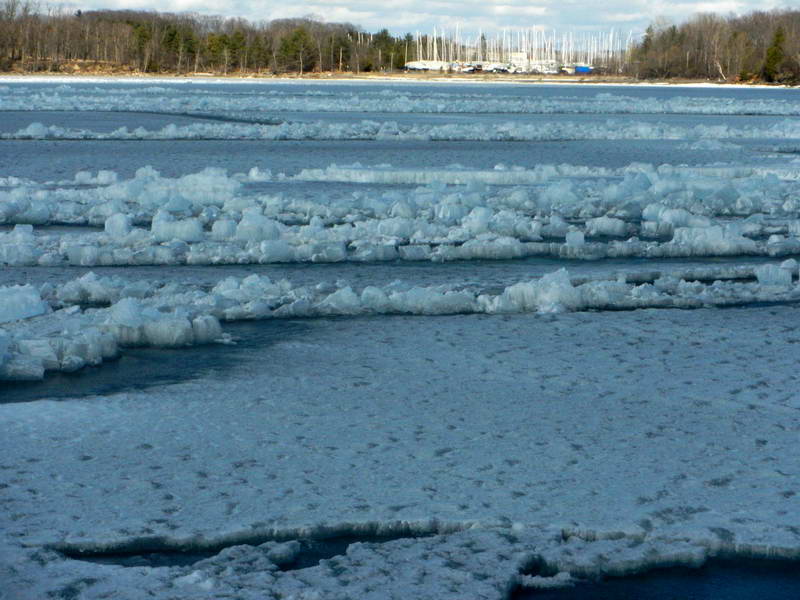When NOT to use an inflatable life-jacket.
 Saturday, April 4, 2015 at 10:23PM
Saturday, April 4, 2015 at 10:23PM 
Heavily finger rafted and well thawed ice. Most of the ice is S1 ice and is reasonably strong for walking on. Some areas are fine grained S2 ice that do not have a second layer under them. They were definitely too weak to hold body weight (thaw stage 6). Continuous use of my test pole kept me from falling through about four times this day.
NOTICE: AUTOMATIC INFLATING AND MANUAL INFLATING LIFE JACKETS MIGHT PRESENT A SIGNIFICANT RISK OF ENTRAPMENT OR PREVENTING BREATHING IN CERTAIN SITUATIONS. This type of lifejacket probably should not be used in thaw conditions or in enclosed vehicles. Entrapment might occur in a plunge through thick but very weak (thawed) small grained ice. This situation also might result in the victim not being able to breathe as a result of the considerable pressure developed by a partially filled life jacket squeezing the victims chest into the wall of the close fitting hole made during the plunge.
Another potential entrapment risk: When exiting a window in a sinking vehicle with an auto-inflating vest might be possible for a victim to be trapped in the window opening if the lifejacket inflates while he is exiting the vehicle.
If you have properly read the directions that came with your life vest you know that you should not wear the vest under a jacket, chest straps on a pack or anything else that can confine the inflation of the lifejacket.
As of today, I no longer wear an inflatable life jacket on ice.
Bob- 4-4-15.
PS: A few days later we put a manual inflation lifejacket on a five gallon pail full of water and put it in a sawed hole that was about 2-1/2" bigger than the bucket. After manual inflation the jacket only partially filled because it was too confined by the small size of the hole. The pressure on the bucket was considerable, probably well in excess of the amount of pressure need to inhibit breathing. I was not able to budge the bucket. Releasing the pressure with a long screwdriver at the manual fill hose released the bucket. If the fill hose is not accessible something sharp will be needed to puncture the life jacket. Ice claws or a test pole should to the trick but I have not tried one to see. I do not know if the pressure is high enough to break ribs or other body parts.
Auto-Inflatable lifejackets are great for summer activities however they have significant drawbacks for use as buoyancy on ice. I am not aware of any accidents where this was a factor and I know of several ice incidents where auto-inflating jackets worked fine (none were the specific ice condition described here).
Bucket with life jacket. The test pole is tied to the manual inflation dongle.
The bucket in position in the hole. The ice is well thawed (stage 4 to 5) S1 ice. The rim of the bucket was at the top of the ice sheet. The ice is about 18" thick.
The inflated life jacket. It was not able to inflate completely and it is quite hard from the pressure inside. I was not able to do anything more than wiggle the bucket a little and I was not even close to being able to pull it out. Potentially, if someone fell through thaw stage six ice the inflation pressure could jam him in place and prevent him from inhaling. Non inflating life jackets are the best choice for lifejackets and there are several other flotation options. Manual inflating jackets are probably OK if you don't panic and pull the dongle and if the dongle does not catch on the ice when you are trying to climb out. Auto inflating jackets should be avoided on ice (especially thawed ice where you are more likely to punch a body sized hole in the ice when you fall in).

Reader Comments